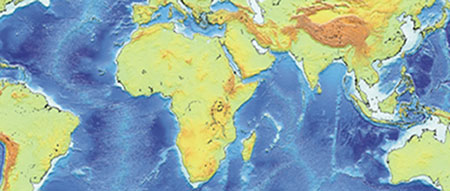African Humid Periods During the Last 130,000 Years
By:
Dr. Oliver Elison TimmPostdoc
University of Hawaii
When: |
Friday, Dec. 11, 2009, 10:30 a.m. to 11:30 a.m. |
Where: |
Seminar Room 1.603, 10100 Burnet Road, Bldg 196, Austin, Texas 78758 |
Host: |
Charles Jackson, UTIG |
Abstract
Paleoclimate proxies from North Africa and surrounding oceans allow
a precisely dated reconstruction of the climate over North Africa
for the last 120,000 years. Most proxies indicate that the last
African Humid Period (AHP) began rather abrupt about 14,500 years
before present (B.P) and ended with a rapid transition from a wet/
vegetated state into the current dry/desert state. In this talk, I
will present a modeling perspective on the North African climate and
vegetation over the last 130,000 years. Our transient paleoclimate
simulations were conducted with an Earth
System Model of Intermediate Complexity, LOVECLIM (a simplified atmosphere-ocean-vegetation model).

In a set of experiments we studied how the formation of the AHP is controlled by summer insolation changes, CO2 changes, and ice-sheet changes in the northern hemisphere.
The results support the earlier hypothesis of deMenocal (and colleagues) that both local forcing from summer insolation and remote forcing from ice-sheets are important for the climate over North Africa and the onset of the AHP. However, we do not find support for a threshold-like response of the African Monsoon system to summer insolation.
We further identify a significant damping of the precession cycles in the North African monsoon climate between 70,000-20,000 BP in the model simulation and the proxy data.




